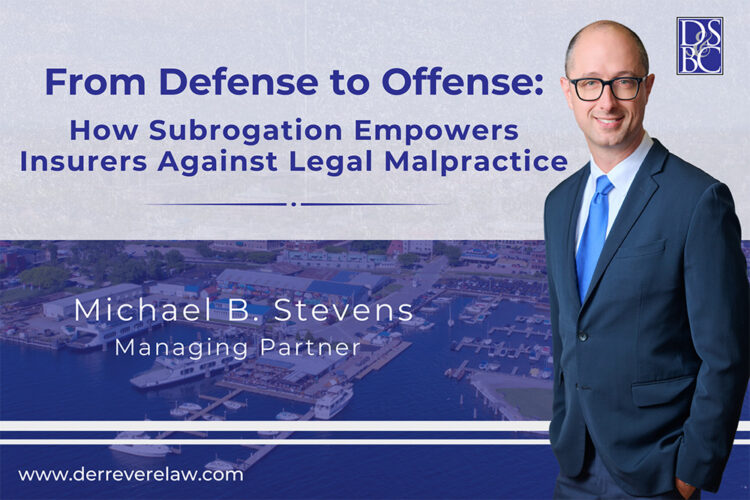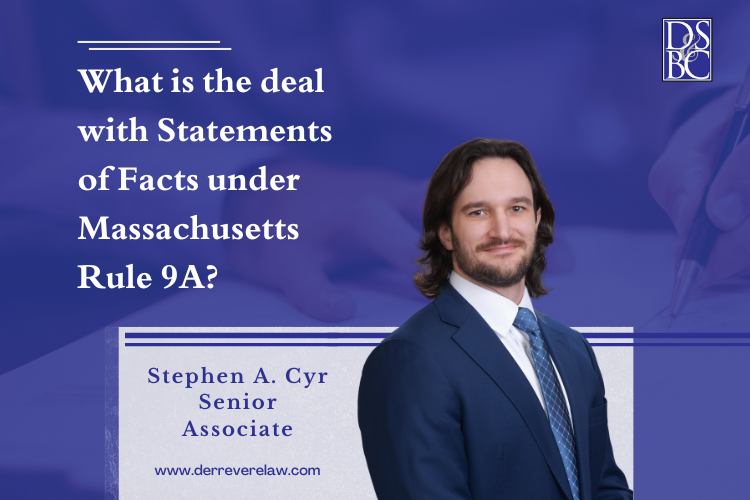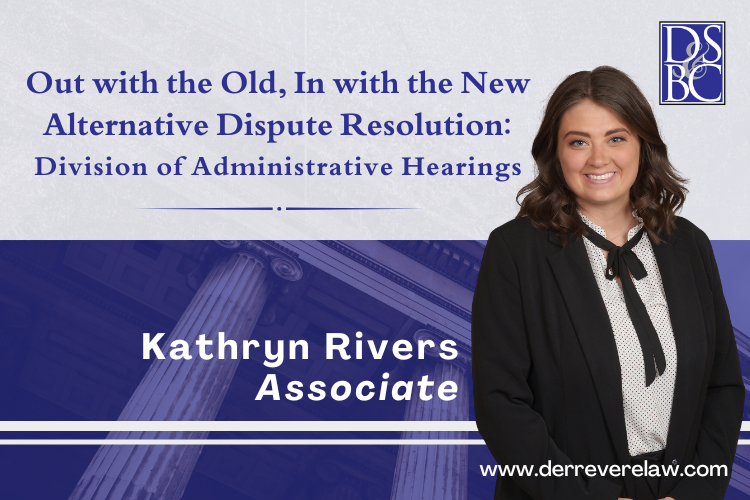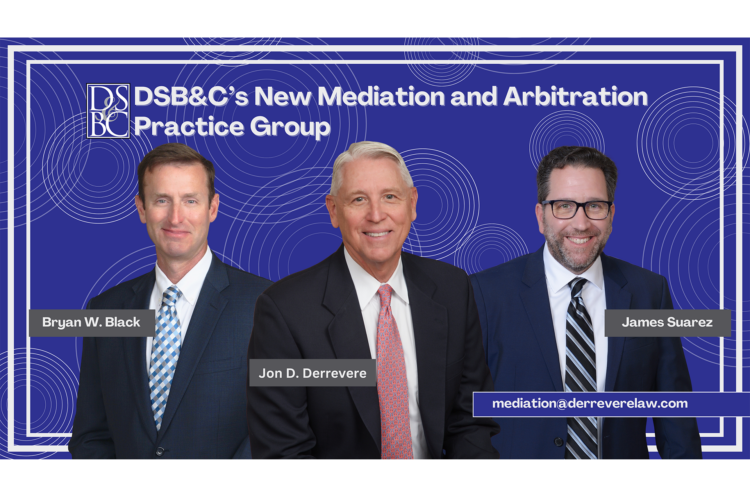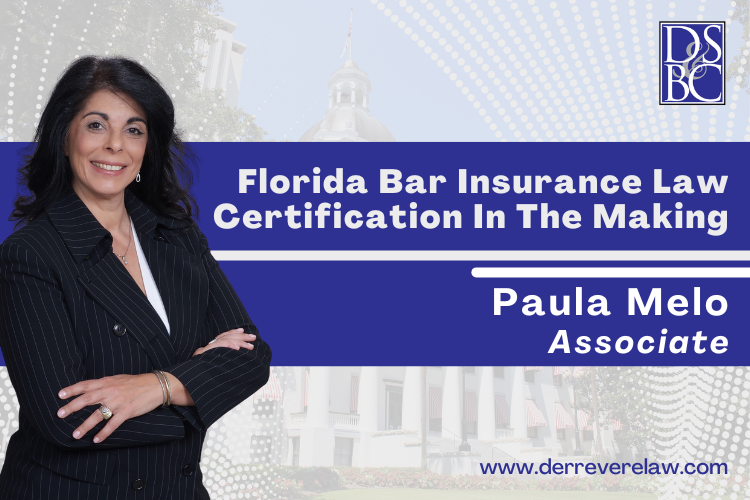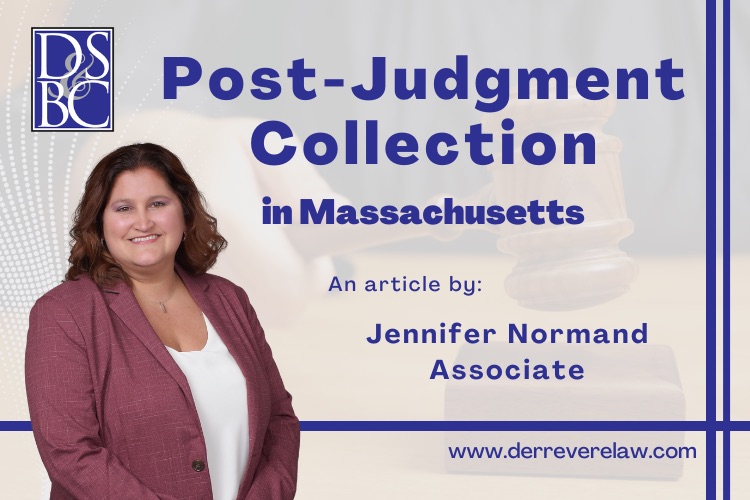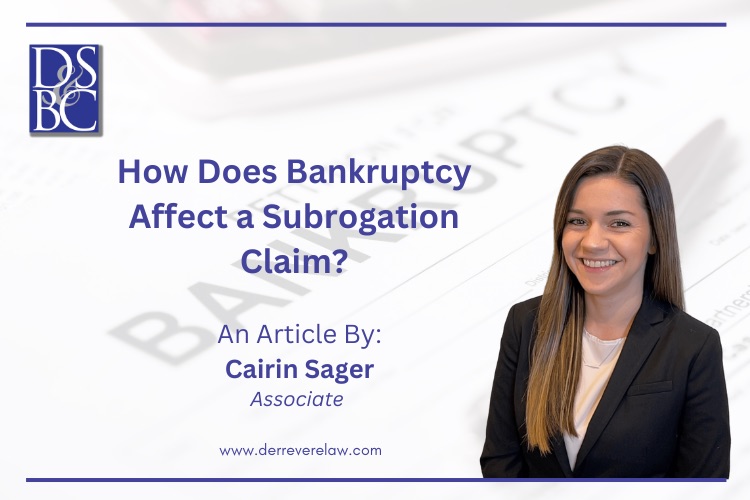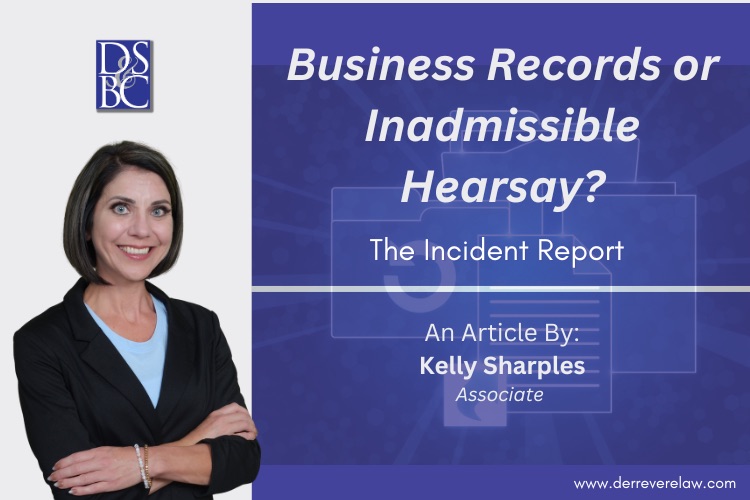February 24, 2025
Derrevere Stevens Black & Cozad Establishes New Executive Leadership Board for Business Development and Client Success
February 24, 2025 – (West Palm Beach, FL) — Derrevere Stevens Black & Cozad (DSB&C) is proud to announce the creation of its Regional Executive Leadership Board for Business Development and Client Success, a new strategic initiative aimed at enhancing client relationships, driving business expansion and strengthening the firm’s presence in key markets. This board has been established to focus on high-level business development, ensuring that DSB&C remains a leader in providing elite legal services in the industry.
Strategic Vision and Impact
The establishment of the Regional Executive Leadership Board underscores DSB&C’s commitment to expanding its market presence, elevating client service and leading the industry with our forward-thinking approach. This new structure is designed to drive long-term partnerships, targeted business strategies and innovation in legal services.
“The formation of this new Board marks an exciting milestone for DSB&C,” said Michael B. Stevens, Managing Partner. “For over 30 years, we have grown strategically—expanding our client base, team and geographic reach through both organic referrals and intentional development. This Board will guide our continued growth in alignment with our culture and vision.”
This announcement comes during a period of a rapid increase in new clients for DSB&C, following its successful expansion from Florida into New England, New York, and New Jersey. The firm has its eyes on additional jurisdictions across the country including Virginia, Pennsylvania and Texas to name a few. With a strong foundation in insurance-related litigation and subrogation, the firm remains committed to delivering strategic, customizable data insights and results-driven legal solutions to its clients nationwide.
Newly Promoted Executive Regional Directors
The foundation of this initiative entails the designation of three Partners in DSB&C’s subrogation practice group who have been promoted to serve on the firm’s Executive Board. Robert Stern, Theodore “Teddy” Stevens, and Milana Amiel have all been promoted to Executive Director of Business Development and Client Success positions each leading a different geographic region. In this new role, each of the new Executive Directors will be dedicated to ensuring the success of the firm’s most complex and sensitive litigation and leveraging their years of experience in the industry to provide “white-glove service”.
Robert Stern – New York, New Jersey, and Pennsylvania Region (Subrogation)
Bringing decades of experience in insurance litigation, subrogation, and business development, Robert Stern has been promoted to Executive Regional Director of Business Development and Client Success for New York, New Jersey and Pennsylvania. A seasoned litigator and President of the Board for the National Association of Subrogation Professionals (NASP), Robert has built a reputation as a leader in shaping best practices and driving client success in the industry. He holds a Juris Doctorate from Boston University School of Law and has successfully investigated, mediated, and litigated thousands of subrogation claims, including numerous high-profile subrogation matters. His leadership in this new role will be crucial as DSB&C continues to strengthen its presence in these key markets.
Theodore “Teddy” Stevens – New England Region (Subrogation)
With a distinguished career in civil litigation, insurance defense, and commercial transactions, Theodore “Teddy” Stevens has been promoted to Executive Regional Director of Business Development and Client Success for New England. A Florida State University graduate, Teddy earned his Juris Doctorate from Florida Coastal School of Law, graduating cum laude. He brings extensive experience in subrogation recovery, construction defect litigation, and product liability. Having practiced in both Florida and New England, Teddy’s transition into this executive role allows him to focus on expanding the firm’s client relationships and market presence across the New England region.
Milana Amiel – Southeast Region (Subrogation)
A highly respected litigator and partner at DSB&C, Milana Amiel has been promoted to Executive Regional Director of Business Development and Client Success for the Southeast Region. With a strong background in insurance subrogation and product liability, Milana’s leadership will be instrumental in expanding the firm’s reach throughout this critical and growing market. Originally from the United Kingdom, Milana earned her Bachelor of Law from the University of Law in London before obtaining her Juris Doctorate from Florida Coastal School of Law, where she graduated cum laude. Now as a member of this Board, Milana will drive client development efforts and strengthen the firm’s presence in Florida and the broader Southeast region.
Please join us in congratulating Robert Stern, Theodore Stevens, and Milana Amiel on their well- earned promotions.
For media inquiries or further information, please contact: Sharon Eisenberger – 561.684.3222 / seisenberger@derreverelaw.com.
February 4, 2025
From Defense to Offense: How Subrogation Empowers Insurers Against Legal Malpractice
In pursuing subrogation cases against law firms for legal malpractice, understanding the framework and recent precedents is essential. Subrogation allows insurers to “stand in the shoes” of their insured, enabling them to pursue claims against third parties responsible for the losses they covered. In legal malpractice contexts, subrogation means that an insurer could pursue a claim against a law firm if the firm negligently represents the insured, thereby increasing the insurer’s liability or settlement costs.
December 10, 2024
What is the deal with Statements of Facts under Massachusetts Rule 9A?
Let’s face the FACTS, as discussed previously Superior Court Rule 9A is as confusing to most attorneys as it would be to non-attorneys. Sometimes this statute can feel like trying to decipher the map to the Holy Grail—so get out your Indiana Jones hat and whip and let’s get cracking.
First and foremost, realize that this is ONLY for Summary Judgment in Superior Court, this does not apply to your District Court cases. So breathe easy my district court brothers and sisters.
What’s the Big Deal About Statements of Facts?
Imagine you are at a dinner party. You have got an amazing story to tell, but if you start rambling on without structure, your audience is going to zone out faster than you can say “objection.” That’s what the statement of undisputed facts does for your motion for summary judgment—it organizes your evidence and keeps the judge engaged. Getting this right is probably the only way a judge will even consider your motion, so a big focus should be paid to this!
The Moving Party’s Statement of Facts
Here’s the lowdown on what you need to serve up as the moving party:
-
- Numbered Format: Think of this as your legal “bullet points.” Each fact gets its own number, making it easy for the court to keep track of your dazzling array of facts.
- Materiality Matters: Only dish out the facts that are essential to the case. No one wants to hear about that time you won the goldfish at the local fair—unless it’s relevant!
- Citations to Evidence: Every fact needs a supporting citation of evidence! Site to them and include them in your Joint Appendix. If you need help, check out my prior blog: Learning to Love Superior Court Rule 9A Pt. II — Summary Judgment
- Disclaimer – This is now a bit out of date because they keep changing these rules, so be sure to double-check the rule!!! You can’t blame me when the court tells you that you filed improperly.
- Clarity is Good: Keep your language straightforward and objective. Remember, you’re aiming to convince, not confuse!
- Do Not:
- Exceed 20 pgs;
- Include background facts not material to a decision (include those in the memo of law);
- Include quotes from any contract, trust, agreement, etc. The Statement of Facts may only seek to establish the existence and authenticity of such documents;
- Use quotations from any statutes, regs, etc.
The Response: Opposing Party’s Turn to Shine
Now, let’s flip the script. The opposing party has a chance to jump into the ring and throw down.
1. Response to the moving party’s statement of facts:
-
- You MUST respond to the moving party’s statement of facts, on the same document.
- Example:
- (Moving Party): Defendant hit Plaintiff’s vehicle. See Exhibit A.
- (Non-Moving Party): Response: Denied. Plaintiff’s car reversed into
Defendant’s vehicle. See Exhibit B.
- Example:
- Do not forget to do this, or fail to deny something that is a death knell for your case—as long as you have evidence to support your denial.
- Supporting Evidence: Don’t just claim something is false—back it up! Cite your sources. Failure to include these can result in the Fact being deemed admitted by the court.
- You MUST respond to the moving party’s statement of facts, on the same document.
2. Statement of Additional Facts:
-
- What the heck is this??
- Just as the moving party gets to lay down their cards, you’ll present your own numbered list of disputed facts. Think of it as your comeback tour! But the rules are super weird on this so get ready.
- Once upon a time as the non-moving/opposing party, you simply added these to a singular Word document called The Statement of Facts. If the moving party had 20 numbered statements, the non-moving party would then start their numbering at 21 on the same document, and then a single Statement of Facts was filed. This made things very easy for the judges to review these together and get input from each party. However, as the rule is written this is no longer the case.
- So, you need to follow: Super. Ct. Rule 9A (b)(5)(iii)(B)
- This is super confusing for most people, even judges. Fun story, one time I was opposing an MSJ. We submitted everything in accordance with the above-referenced rule, i.e. we had a separate statement of facts and the judge ordered us to disobey the rule and submit a Joint Statement of Facts as it was laid out under the old rule. We of course complied. When we had our hearing on this, I was bold enough to ask the judge why we were required to submit in a way that did not comply with the rule, and the judge explained that they hated the new rule and argued against it when it was proposed. So the lesson, be flexible and do as the judge says!
- What the heck is this??
Conclusion
The Statement of Facts (moving party), Response to the Statement of Facts (non-moving party), and Statement of Additional Facts (non-moving party) are by no means easy to understand. But with the right amount of focus, you can sort through the chaos, and reach that Holy Grail of a compliant 9A package—“it belongs in a museum!”
November 25, 2024
Out with the Old, In with the New Alternative Dispute Resolution: Division of Administrative Hearings
Pursuant to the Personal Lines Bulletin from Citizens on December 6, 2022, beginning February 2023, a new form of alternative dispute resolution was implemented by Citizens Property Insurance Corporation. It is a means to avoid lengthy litigation in favor of an expedited track for resolution. Utilizing the State of Florida Division of Administrative Hearings (DOAH), disputes regarding coverage and/or scope and price of claims can now be resolved within four months or less.
What is the Division of Administrative Hearings?
The Division of Administrative Hearings is an independent agency responsible for conducting administrative hearings and handling dispute resolutions. The Florida division provides independent judges to conduct hearings on the matters. All disputes are resolved by judges, without the use of a jury. All matters within DOAH will culminate in a final arbitration hearing held via Zoom over a two-day period. Here, both the Insured and Citizens will have the opportunity to present their case using exhibits, calling witnesses, and presenting expert testimony, just as they would in a regular jury trial; however, the Administrative Law Judge will be the one issuing a final order on the matter after observing the proceedings.
What type of cases can be resolved using DOAH?
Most all of Citizens claim disputes can be resolved utilizing this alternative form of dispute resolution. However, the following claims are not eligible for DOAH:
- Sinkhole claims
- Claims regarding Citizens’ Managed Repair Program
How will you know if a claim is being resolved via DOAH?
Effective February 1, 2023, Citizens will be utilizing new policy endorsements which provides Citizens or the Insured the right to “invoke” the Division of Administrative Hearings as a form of Alternative Dispute Resolution. The Insured, themselves, can invoke this form of ADR by submitting a written request to Citizens. However, often times, the invocation is made in response to an Insureds’ Notice of Intent to Initiate Litigation.
As required by Florida Statute 627.70152, an Insured must file a Notice of Intent to Initiate Litigation if there is a disagreement surrounding an Insureds’ claim. The Insurer then has an obligation to respond to the Notice of Intent to Initiate Litigation within ten business days. It is during this time that Citizens can choose to invoke the Division of Administrative Hearings. Citizens will respond to the Insured stating that in response to the Insureds’ Notice of Intent to Initiate Litigation, that Citizens will be utilizing the Division of Administrative Hearings Alternative Dispute Resolution. Whoever invokes this form of ADR would then file a Written Petition for Formal Hearing with the Division of Administrative Hearing, which outlines the general facts of the case and dispute. Once accepted, both parties, through their legal counsel, will receive a “Notice of Arbitration Hearing by Zoom Conference,” which establishes the date of the final arbitration hearing, as well as several other deadlines to comply with throughout the DOAH process.
What deadlines should you be aware of?
Each Notice of Arbitration Hearing is different, and not all may require these deadlines; however, below is an outline of pertinent deadlines to be aware of in most DOAH matters:
- Filing Notice of Appearance: this must be done by both parties immediately upon receiving notice of the DOAH matter.
- Filing Certified Copy of Policy: not all Administrative Judges require this, but the vast majority order that a Certified Copy of the Insured’s Policy must be filed within thirty days of the initiation of proceedings.
- Discovery Deadline: Discovery of all sorts must be completed ten days prior to the final arbitration hearing.
- Deadline for Written Expert Report: Most reports state a date certain for expert reports to be filed. This often falls within two months of the initiation of the proceedings. Petitioners will be required to file their expert report first, followed by Respondents’ report about two weeks after.
- Pre-Hearing Meeting of Parties: No less than fifteen days prior to the final hearing, the parties must meet and confer to:
- (a) Discuss the possibility of settlement;
- (b) Stipulate to as many facts and issues as possible;
- (c) Prepare the pre-hearing stipulation required by this Order;
- (d) Examine all exhibits proposed to be offered into evidence at the hearing;
- (e) Furnish the opposing party the names and addresses of all witnesses who may testify at the hearing; and
- (f) Complete all other matters which may expedite the hearing in this case.
- Pre-Hearing Stipulation: No less than seven days prior to the final hearing, the parties must submit a joint pre-hearing stipulation, that includes:
- (a) A concise statement of the nature of the controversy;
- (b) A brief, general statement of each party’s position;
- (c) A list of all exhibits to be offered at the hearing, noting any objections thereto, and specifying the grounds for each objection (objections not noted are waived);
- (d) The names and addresses of all witnesses to be called at the hearing by each party, with the field of expertise designated for any expert witness;
- (e) A concise statement of those admitted facts requiring no proof at hearing;
- (f) A concise statement of those issues of fact which remain to be litigated;
- (g) A concise statement of those issues of law on which there is agreement;
- (h) A concise statement of those issues of law remaining for determination by the ALJ;
- (i) A concise statement of any disagreement as to the application of the rules of evidence;
- (j) A list of all pending motions or other matters which require action by the ALJ;
- (k) An estimate of the length of time required for the hearing; and
- (l) The signature of all parties or their counsel.
- Exhibits: No later than seven days prior to the hearing, the parties must number and file the exhibits they plan on utilizing at the final arbitration hearing.
DOAH vs. Litigation – key differences to be aware of:
The key component that differentiates DOAH from typical litigation is the timing aspect. The goal of utilizing DOAH is to reduce the time that it takes for claim disputes to be resolved. With this, comes several practices and procedures that differ from typical litigation.
- Responsive Pleadings: A Respondent may, but is not required to, file a responsive pleading to the petition.
- Discovery: While discovery is still governed by the Florida Rules of Civil Procedure and the Florida Evidentiary Code, the Administrative Law Judges have the discretion to amend these rules as needed. Once main difference is that in serving requests for discovery, including interrogatories, admissions, and production, the responding party now only has fourteen days to respond instead of the typical thirty.
- Motion Practice and Hearings: Most motions are resolved without the need for a hearing. Unless explicitly ordered by the Administrative Judge, when a motion is filed, the judge will read the contents of the motion and response (if any) and either: 1). Order a hearing to occur within the next five (5) days, or 2). Rule on the motion based on its merits without the need for a hearing. The vast majority of motions get ruled on without a hearing. Additionally, if a motion is “agreed to” the parties must expressly state what is agreed upon and the judge will issue their order accordingly. Submitting a separate agreed order is not the proper procedure in DOAH.
- Meet and Confer Requirement: Any party filing a motion must include a “Certification of Good Faith Meet and Confer”, which outlines the attempts at discussing the contents of the motion with the opposing party and the outline of those attempts. Any motion that does not reflect this certification will likely be denied.
- Expert Reports: All expert reports must be filed on the DOAH docket and include the following information:
- (i) a complete statement of opinions the witness will express and the basis and reasons for them;
- (ii) the facts or data considered by the witness in forming them;
- (iii) any exhibits that will be used to summarize or support them;
- (iv) the witness’ qualifications, including a list of all publications authored in the previous ten years;
- (v) a list of all other matters in which the witness testified as an expert at trial or by deposition in the past four years; and
- (vi) a statement of compensation to be paid for the study and testimony in the case.
- Final Hearings: The use of final arbitration hearings differs from a typical jury trial. The parties will meet via Zoom at the final hearing. There will be no jury present and the administrative law judge will be the governing body and issue the final order. The parties can present their evidence using exhibits and testimony; however, the use of objections is more limited and not used as abundantly.
The Division of Administrative Hearings is a relatively new form of alternative dispute resolution. As there is not much research or statistics on it, it remains to be seen whether or not this becomes more utilized than regular litigation and how effective it will be. For more information on the Division of Administrative Hearings, see https://www.doah.state.fl.us/ALJ/.
November 18, 2024
Ringing in the New Year with New Florida Civil Rules of Procedure Effective January 1, 2025
For many years courts have been burdened with delays in moving cases to conclusion, primarily because attorneys were not diligent in preparing cases for trial, resulting in attorneys requesting continuances to obtain additional time to prepare for trial. One of the reasons for delays arose from the discovery process. Attorneys would delay in propounding or responding to discovery requests, or would become embroiled in discovery disputes with opposing counsel, often involving bad faith discovery requests or responses. Judges expended needless additional time to resolve these disputes, eventually causing cases to be continued, often multiple times. The pandemic magnified these problems. While the courts began to rely more heavily on case management orders containing deadlines to accelerate cases to trial, the case management orders did not resolve the delays resulting from discovery delays and disputes. In some cases, the use of case management orders created confusion when case management deadlines conflicted with deadlines in trial orders.
Therefore, on May 23, 2024, the Florida Supreme Court amended the Florida Rules of Civil Procedure, effective January 1, 2025, to address these problems. In doing so, the Supreme Court significantly changed the litigation landscape in Florida state courts. These new procedures provide a more robust calendaring system through the use of more robust case management orders, and severely restrict the ability of parties to obtain continuances necessitated by the failure of attorneys to prepare for trial in accordance with the deadlines imposed. Furthermore, the new rules are designed to streamline and accelerate the discovery process, including by adding provisions similar to the discovery procedure in Federal court and discouraging bad faith discovery requests and responses. By separate order, the Supreme Court also amended the timing requirements for summary judgments, consistent with these amendments.
Trial Management:
The Supreme Court completely rewrote Fla. R. Civ. P. 1.200 to require courts to assign most civil cases to one of three tracks within the earlier of 120 days after commencement of the case or 30 days after service of the complaint on the last-named defendant. The assignment is to be made either by a case management order or pursuant to an administrative order issued by the chief judge of the circuit. The three tracks are streamlined, general, or complex. The case tracks are based on the expected amount of judicial intervention necessary. Cases assigned to the complex track will proceed under Fla. R. Civ. P. 1.201, which was not significantly amended. The remaining cases will be assigned to either a streamlined or general track. Parties are permitted to move for a change in a track, provided the motion is filed promptly, with good cause to support the motion. The court also may change the track assignment on its own motion. The track assignment is based on the amount of judicial attention required for resolution.
A trial court must issue a case management order that specifies a projected or actual trial period based on the case track assignment. (Interestingly, the rule does not provide for a deadline for the court to issue a case management order itself. Presumably, that deadline will be established by administrative order.) The case management order must specify the projected or actual trial date based on the track assignment. Absent an administrative order providing for different time periods, streamlined cases will be expected to be ready for trial in 12 months, and general cases will be expected to be ready for trial in 18 months.
The case management order must also specify deadlines, including eight specified deadlines, which include deadlines for service of complaints, adding new parties, completion of discovery, resolution of objections to pleadings, resolution of all pretrial motions, and completion of mediation or other alternative dispute resolution. Administrative orders may require additional deadlines, such as witness and exhibit lists, to be included in the case management rather than in the trial order.
The case management deadlines are to be strictly enforced, but parties may submit an agreed order to extend a deadline if the extension does not affect the ability to comply with the remaining deadlines in the case management order. Any other change to deadlines requires a motion to amend the case management order, rather than submitting a motion for extension of an individual deadline. The new rule explicitly provides that a notice of unavailability will have no effect on the deadlines set by a case management order absent an order amending deadlines or amending the case management order.
The Supreme Court also made significant changes to Fla. R. Civ. P. 1.440, regarding setting cases for trial to provide that a case no longer has to be at issue (the pleadings have been closed) for trial to be set. The court must set the case for trial at least 45 days prior to the projected trial date in the case management order. Any order setting the trial period must set the trial to begin at least 30 days after the date of the service of the order, unless all parties agree otherwise.
The Supreme Court also rewrote Fla. R. Civ. P. 1.460, regarding continuances, to limit the grounds to obtain a continuance of trial. The revised rule explicitly provides that motions to continue a trial are disfavored and should be rarely granted – and then only upon good cause shown. The rule also explicitly provides that lack of due diligence in preparing for trial is not grounds to continue the case. The moving party must make reasonable efforts to confer with the nonmoving party about the need for a continuance. The nonmoving party must cooperate in responding and holding the conference. Even if the motion is agreed to by the parties, the motion must state the basis for the continuance and when the basis became known to the movant, the proposed date by which the parties expect to be ready for trial, and the action and specific dates for the action that will enable movant to be ready for trial. If a continuance is based on dilatory conduct of an attorney or a party, the court may impose sanctions on the attorney, party, or both.
Discovery:
The Supreme Court has significantly amended the discovery rules to bring them more in line with the Federal rules. Fla. R. Civ. P. 1.280(a) will require that the following initial discovery disclosures be made within 60 days after service of the complaint:
(A) the name and, if known, the address, telephone number, and e-mail address of each individual likely to have discoverable information, and the subjects of that information, other than information solely for impeachment;
(B) a copy or a description by category and location of all documents, electronically stored or otherwise, that the disclosing party has in its possession, custody, or control or a description by category and location of such information that the party may use to support its claims or defenses, unless the use would be solely for impeachment;
(C) a computation for each category of economic damages claimed by the disclosing party, including materials bearing on the nature and extent of injuries suffered; and the identification of categories of damages claimed, together with supporting documents; and
(D) a copy of any insurance policy for which the proceeds may be available to satisfy all or part of a possible judgment in the action or to indemnify or reimburse for payments made to satisfy the judgment.
A party is not excused from making its initial discovery disclosures because it has not fully investigated the case, because it challenges the sufficiency of another party’s initial discovery disclosures, or because another party has not made its initial discovery disclosures. Any objection to providing certain information does not excuse disclosures of remaining information.
The Supreme Court also addressed overbroad or irrelevant discovery requests by amending the scope of discovery defined in Fla. R. Civ. P. 1.280 to provide that discovery must be relevant to any party’s claim or defense and must be proportional to the needs of the case, considering the importance of the issues, the amount in controversy, the parties’ relative access to relevant information, the parties’ resources, the importance of the discovery in resolving the issues, and whether the burden or expense of the proposed discovery outweighs its likely benefit. Information within this scope of discovery need not be admissible in evidence to be discoverable.
Previously, under Florida rules, parties responding to written discovery were not obligated to update previous discovery responses as the case progressed and additional information became available. This resulted in parties having to serve multiple updated discovery requests to obtain new information. Under the new rules, parties who have made the initial disclosure or who have responded to written discovery must supplement or correct its initial disclosure or written discovery responses in a timely manner if the party learns that in some material respect the disclosure or responses are incomplete or incorrect, or as ordered by the court. There is no language requiring third parties responding to subpoenas, such as medical providers, to supplement the responses to subpoenas. Therefore, parties will presumably be required to update their nonparty requests for production, and possibly nonparty depositions, as the case progresses.
The Supreme Court also addressed bad faith or vexatious discovery requests and responses by adding a new subsection (k) to Fla. R. Civ. P. 1.280. Under this subsection, all parties, whether represented by attorney or pro se, must certify in writing, under signature, that disclosures are complete and correct at the time they were made, and that any discovery request, response or objection is consistent with the rules and is made in good faith. No party has a duty to act on an unsigned disclosure, request, response, or objection until it is signed.
May 23, 2024 Supplemental Supreme Court Order:
The deadlines for the filing of a summary judgment and responses to a summary judgment will no longer be based on a certain number of days before the trial period. The new rules regarding case management orders include deadlines for filing a summary judgment. The response to a summary judgment must be filed within 60 days after the filing of the motion for summary judgment. It is thus contemplated that the deadline for summary judgment motions will likely have to be well before 60 days prior to the commencement of the trial period.
The Supreme Court also added a new Florida rule – Fla. R. Civ. P. 1.202, Conferral Prior to Filing Motions, requiring the parties to confer before setting any non-dispositive motion for hearing, similar to Federal requirements. A certificate of conferral is required. The parties are expected to confer and attempt to resolve the issues before reserving hearing time.
Conclusion
The Supreme Court states that its purpose in amending the Rules is to create a framework for the active case management of civil cases with a focus on adhering to deadlines established early based on the complexity of the case, while providing room for customization by judicial circuit given the varying levels of volume, resources, and available automation, and to provide more effective discovery procedures. It is the Supreme Court’s intent that the amendments will promote the fair and timely resolution of civil cases.
November 11, 2024
Derrevere Stevens Black & Cozad Launches Dedicated Mediation Practice
FOR IMMEDIATE RELEASE
November 11, 2024 – (West Palm Beach, FL) —- Derrevere Stevens Black & Cozad (“DSB&C”), a multi-state law firm based in Florida, is excited to announce the launch of its new Mediation Practice Group. Given our firm’s established excellence and commitment to innovative legal solutions, the introduction of a Mediation Practice Group is a natural and exciting next step. This development underscores our dedication to providing exceptional legal services, emphasizing personal attention, and resolving disputes efficiently and effectively.
Our Mediation Practice is led by respected attorneys with extensive experience in managing complex disputes across various practice areas. Our Florida Supreme Court Certified Circuit Court Mediators focus on facilitating fair and equitable outcomes for all parties involved, reducing the need for lengthy litigation. Whether through Zoom, hybrid, or in-person sessions, we handle disputes with professionalism and integrity.
Meet Our Florida Supreme Court Certified Circuit Court Mediators
Jon Derrevere
As the founder and cornerstone of our firm, Jon Derrevere brings over four decades of legal experience as a distinguished mediator, arbitrator, and trial attorney. A graduate of the University of Florida and Cornell University, Jon has tried over 200 cases and specializes in complex litigation, particularly in construction, product liability, and large-loss recovery claims. As a Florida Supreme Court Certified Circuit Court Mediator, Jon brings unparalleled expertise to every session.
Bryan W. Black
Bryan W. Black, with his profound knowledge of the Florida legal landscape, offers extensive experience in our mediation practice. After graduating from Western Carolina University and Nova Southeastern University Shepard Broad Law Center, Bryan has excelled in various practice areas, including construction and insurance defense. His role as a Florida Supreme Court Certified Circuit Court Mediator complements his leadership and legal acumen, enhancing our firm’s mediation services. With Bryan W. Black on our mediation team, clients can trust in his unwavering commitment to achieving favorable outcomes and delivering exceptional service.
James Suarez
James Suarez combines his broad legal background with a personal approach to his mediation sessions, ensuring that each party’s perspective is fully considered. Fluent in Spanish, James also facilitates effective communication for Spanish-speaking parties, enhancing the mediation experience for a diverse range of participants. A graduate of Florida International University and The George Washington University Law School, James has built a dynamic legal career focusing on complex litigation and insurance defense. As a Florida Supreme Court Certified Circuit Court Mediator, James’s diverse experience and dedication to conflict resolution brings a unique depth to our mediation team. James is also a Florida Supreme Court Qualified Arbitrator.
Contact Information
For more information about our Mediation Practice or to schedule a consultation, please contact:
Mediation Coordinator: Ana Torres
Email: mediation@derreverelaw.com
Telephone: 561-449-0740
About Derrevere Stevens Black & Cozad
Derrevere Stevens Black & Cozad is a prominent law firm dedicated to providing top-tier legal services and innovative dispute resolution solutions. Our team is committed to meeting the unique needs of each client with professionalism and care.
October 17, 2024
Florida Bar Insurance Law Certification in The Making
It is no secret that the Florida insurance saga has produced a considerable number of lawsuits in the past few years. Official data shows that at the peak of the homeowners’ insurance crisis, Florida had 79% of the entire country’s total homeowner insurance lawsuits. As a result, Florida cultivated a large class of attorneys with a unique and vast expertise in insurance law. Nonetheless, none of those attorneys can apply to be “board certified” in insurance law because, surprisingly, the Florida Bar does not offer such certification as an option.
Established by the Florida Supreme Court in 1982 and administered by The Florida Bar, board certification is an independent process that evaluates an attorney’s level of excellence through character, professionalism, ethics, and credibility in the practice of law to determine if such attorney has achieved a heightened level of professional expertise in a particular legal field.
With the purpose of making the certification available to Florida insurance attorneys, the Insurance and Surety Committee of the Real Property, Probate & Trust Law Section recently filed an application with the Florida Bar to create the “insurance coverage law” certification. According to an article on The Florida Bar website, the proposal defines the expertise as “the practice of law that involves issues, disputes, and matters among or between insurers, policyholders, or third-party insurance policy beneficiaries concerning the rights, duties, responsibilities, and coverages that arise out of insurance policies.” Included subspecialties are first-party, third-party, bad faith/extra contractual claims, and state regulatory procedures and practices, which would be part of (not separate or in addition to) the “Insurance Coverage Law Board certification”.
The application reportedly follows an extensive survey conducted with every Bar committee that revealed strong support for the initiative, culminating with 258 insurance lawyers signing their support for the initiative. It is estimated that if approved, as many as 200 Florida attorneys could be board certified in insurance coverage law within the next few years.
Under the proposal, the process for the insurance law certification would evaluate skills such as “the areas of contract formation and cancellation, insurance policy construction, insurance policy interpretation, property insurance, liability insurance, insurance coverage litigation, reinsurance, bad faith/extra contractual litigation, recurring issues in insurance coverage professional responsibility, and other types of insurance, such as life and disability, professional liability, directors and officers, employment practices, commercial crime and fidelity, excess, umbrella, environmental, workers’ compensation, builder’s risk, and OCIPs/CCIPs.”
The initiative aims to provide insurance attorneys with the chance to obtain a reputable accreditation to reinforce the quality of their practice and at the same time to elevate the standards of the insurance sector as a whole. The Property Insurance Section of the Florida Justice Association, one of the active supporters of the proposal, has stated that an insurance certification “would help Florida consumers to identify the most competent lawyers and would also help business owners with risk assessment.” Other supporters of the application are the consumer advocate group, United Policy Holders, and the Florida Defense Lawyers Association, with 1,300 members involved with civil litigation defense, according to the organization’s website.
The Florida Bar has one of the most diversified board certification programs in the country, offering certification in 27 areas of law. Attorneys can seek certification in areas such as Antitrust & Trade Regulation Law, Immigration & Nationality, Aviation Law, Appellate Practice, Business Litigation, and International Law, just to name a few. There are currently a little over 5,000 board certified attorneys in Florida, which represents roughly 5% of the total licensed attorneys.
For each area of certification, the rules and requirements may vary. However, minimum standards for most of the processes will likely include:
- Practice of law for at least five years;
- Substantial involvement in the specialty — 30%-50% or more — during the
three years immediately preceding application; - Minimum number of hours of approved continuing legal education in the three
years immediately preceding application; - Peer review; and,
- A written examination.
Some processes have specific additional requirements. For instance, to become a Board-Certified Civil Trial attorney, the applicant must also provide evidence that he/she has handled “at least 15 contested civil cases, including cases before juries as lead counsel and as trier of fact on some or all of the issues.” For an Appellate Practice certification, it is necessary to provide evidence of handling at least 25 appellate actions and five appellate oral arguments during the five years immediately preceding application as well.
All certifications are required to be renewed every five years, and the current costs associated with obtaining a board certification in Florida are: $250 Application Fee; $150 Exam Fee; $150 Annual Fee (for each year except the 5th year when renewal occurs); $250 Renewal Fee (every 5th year).
Despite predictions that the recent reforms in Torts and Property Insurance legislation could force some legal professionals to pivot to other areas, the number of insurance attorneys and insurance law firms seem to keep growing strong in Florida. The idea of being able to add the words “Board Certified” to the name might be appealing to some insurance attorneys that wish to stand out in the crowd. We’ll just have to wait and see!
September 3, 2024
A Guide to Post-Judgment Collection in Massachusetts
As post-judgement collection varies state-by-state, knowing how and when you can collect in your state is paramount. This post will tackle post-judgments in Massachusetts. Judgments in Massachusetts are valid for twenty (20) years from the date of issuance. At the end of the 20-year period, there is a presumption that the debt has been satisfied. However, if the debt is still owed at the end of twenty (20) years, a judgment creditor may move the Court to extend the judgment.
The first step following the issuance of a judgment in a creditor’s favor is to request the original execution from the Court. Pursuant to M.G.L. c. 235, § 17, an execution on a judgment cannot be issued by the Court as a matter of right more than one (1) year after the judgment issues. If a creditor fails to timely request the execution, the creditor will have to file a motion for the issuance of an execution which is at the discretion of the Judge hearing the motion, but subject to the “level of process and judicial scrutiny commensurate with our motion practice.” First National Bank of Boston v. Bernier, 50 Mass.App.Ct. 756 (2001). See also, M.G.L. c. 235, § 19.
In the event a Court has already approved a real estate attachment in favor of the creditor that was recorded in the Registry of Deeds, the resulting execution must be recorded within thirty (30) days of its issuance in order for the execution to date back to the attachment’s lien position. If the original execution is lost, the creditor can move for the issuance of an alias execution in order to pursue collection remedies. M.G.L. c. 235, § 17.
An original execution is needed to take any of the following post-collection actions: (1) record and/or levy against any real property owned by the defendants; (2) to file a supplementary process action to obtain an order for payment from the Court; (3) a bank attachment and/or wage garnishment; and/or (4) to domesticate your judgment in a foreign jurisdiction.
After a creditor has paid all of the amounts owing under the judgment, including interest at a rate of 12% per year, the original execution must be returned to the Court as satisfied within ten (10) days pursuant to M.G.L. c. 235, § 17. If the Execution is not available for return, a party can file a discharge of judgment in its place, but it should also be filed within ten (10) days of satisfaction of the judgment and execution.
May 7, 2024
How Does Bankruptcy Affect a Subrogation Claim?
Bankruptcy is a scary word… and the implications can be felt far and wide. This article will focus on the impact of bankruptcy on a subrogation claim.
Bankruptcy is a legal process through which people or other entities who cannot repay debts to creditors may seek relief from some or all of their debts. In most jurisdictions, bankruptcy is imposed by a court order. Bankruptcy can have serious long-term financial and legal consequences.
There are several types of bankruptcy, classified into “chapters,” in reference to each chapter of the United States Bankruptcy Code:
- Chapter 7: Also known as “liquidation” or “straight” bankruptcy, it is the most common type. In Chapter 7, a debtor’s non-exempt assets (if any exist) are sold off to pay as much of the debt as possible. Remaining eligible debts are then discharged, freeing the debtor from them.
- Chapter 13: This type of bankruptcy is more of a reorganization for individuals. Instead of selling off assets, the debtor is put on a payment plan of 3 to 5 years to pay off all or part of their debts. Only individuals with a regular income are eligible for Chapter 13 bankruptcy.
- Chapter 11: This is most commonly used by businesses. Similar to Chapter 13, it allows for a reorganization of debt so the debtor can keep their business operational while repaying creditors over time.
- Chapter 12: This is specifically for family farmers and fishermen, allowing them to continue their operations while repaying their debts.
In cases where a defendant goes bankrupt during litigation, but insurance exists covering the plaintiff’s claims, there is a basis to obtain relief from the bankruptcy stay and continue to pursue litigation and obtain funds from the insurance proceeds.
For purposes of litigation, if the insured is an undischarged bankrupt, bring the subrogated action in the name of the insured’s trustee in bankruptcy (with notice as required by the Bankruptcy Code). Courts will look at insurers as sophisticated and capable parties and hold them to a higher standard for litigation.
The following steps briefly outline the effect bankruptcy can have on a subrogation claim, specifically. Keep in mind that there are several additional parties and subrogation claims tend to fall lower on the priority list in Bankruptcy litigation.
1. Automatic Stay: Once a debtor files for bankruptcy, an automatic stay is initiated, which stops all collection efforts against the debtor. This includes subrogation claims. Collection efforts cannot resume until the stay is lifted or the bankruptcy case is closed, dismissed, or discharged.
United States Bankruptcy Code Section 362 automatically imposes a stay on all actions against a debtor who files for bankruptcy. This means that any and all lawsuits against the person or entity filing, even those that are unrelated to the bankruptcy, are put on hold. The stay is immediately effective whether or not a creditor, such as a plaintiff in a personal injury case, receives notice of the stay and regardless of whether the court makes an order entering it.
However, Bankruptcy Code Section 362 also provides an outlet to overcome the automatic stay. Section 362(d)(1) provides that on the request of a party and after notice and a hearing, the court shall grant relief from the stay for “cause, including the lack of adequate protection of an interest in property of such party in interest.” Although the grounds for relief from a bankruptcy stay for cause includes lack of adequate protection of an interest in property, relief from a stay is not limited to that reason.
2. Priority of Claims: In bankruptcy, claims are paid in a hierarchy or order set by the bankruptcy code. Secured creditors are typically paid first, followed by unsecured creditors. Subrogation claims are categorized as general unsecured claims, which are paid after priority unsecured claims. In terms of the hierarchy or order, this leaves subrogation claims towards the end of the payout and may leave little to no money to satisfy a subrogation claim.
However, in a Chapter 7 bankruptcy, unsecured debts are normally discharged, meaning the debtor is no longer legally required to pay them. Conversely, in a Chapter 13 bankruptcy, the debtor will pay a portion or all of the unsecured debts through the repayment plan, depending on their income, expenses, and types of debt owed. See below.
3. Discharge of Debts: If the debtor receives a discharge in bankruptcy, most debts are wiped out, including subrogation claims. This means the subrogated party cannot collect on the debt, even after the bankruptcy case is closed.
4. Proof of Claim: To participate as a creditor in a bankruptcy case, the subrogated party must file a proof of claim in the bankruptcy court. If a proof of claim is not filed, the subrogated party may not receive any distribution from the bankruptcy estate. This is a firm rule of the Bankruptcy Court.
5. Reaffirmation: In some cases, although rare, a debtor may decide to reaffirm a specific debt, meaning they agree to repay a debt even though it could be discharged in the bankruptcy decision.
6. Chapter 13 Bankruptcy: If the debtor files for Chapter 13 bankruptcy, they will propose a repayment plan to pay off their debts over a period of three to five years. This plan may include paying off a subrogation claim, although not guaranteed if there are little to no funds allotted for the repayment plan.
It has been well settled that “cause” for relief from a bankruptcy litigation stay is not defined in the Bankruptcy Code and is handled on a case-by-case basis. (In re Fernstrom Storage and Van Co. (7th Cir. 1991) 938 F.2d 731, 735 (C.A 7 1991).) The moving party is only required to make an initial showing that he is entitled to relief from the stay, the burden then moves to the debtor to overcome that showing. (In re Sonnax Industries, Inc. (2nd Cir. 1990) 907 F.2d 1280, 1285.) Overall, a bankruptcy filing is truly handled on the merits of each case individually, there is never a guarantee to a payout as a creditor, whether that is a subrogation claim or not. The above is a very general outline of steps and potential outcomes, it does not reflect the typical outcome of each case.
April 26, 2024
Business Records or Inadmissible Hearsay? The Incident Report
Business records prepared in anticipation of litigation serve a crucial role in helping businesses prepare for potential legal challenges, protect their interests, and comply with legal requirements. These records are essential for evidence preservation, legal strategy development, and risk management in the face of future legal disputes or regulatory investigations. The primary purpose is to prepare the business for potential legal challenges by gathering relevant information, documents, and evidence. Documents that might be traditionally hearsay can be offered into evidence at trial if the proponent can meet the requirements as a Business Record Exception to Florida’s hearsay rule. “Florida’s business-records exception appears in section 90.803(6)(a), Florida Statutes (2004).” Yisrael v. State, 993 So. 2d 952, 956 (Fla. 2008). “To secure admissibility under this exception, the proponent must show that (1) the record was made at or near the time of the event; (2) was made by or from information transmitted by a person with knowledge; (3) was kept in the ordinary course of a regularly conducted business activity; and (4) that it was a regular practice of that business to make such a record.” Id. Additionally: [T]he proponent is required to present this information in one of three formats.
First, the proponent may take the traditional route, which requires that a records custodian take the stand and testify under oath to the predicate requirements. See § 90.803(6)(a), Fla. Stat. (2004). Second, the parties may stipulate to the admissibility of a document as a business record. Third and finally, since July 1, 2003, the proponent has been able to establish the business-records predicate through a certification or declaration that complies with sections 90.803(6)(c) and 90.902(11), Florida Statutes (2004).” Id. at 956-57.
The Business Record exception to the hearsay rule offers parties an “easy way,” to admit documents such as accounting statements, balance sheets, income statements, transaction logs,copies of contracts, agreements, and other legally binding documents related to business operations, partnerships, or transactions, emails, letters, memos, internal investigations, or incident reports. Via the testimony of a records’ custodian at trial, and so long as the proponent of such evidence lays the proper statutory predicate, a business record may be admitted at trial without the necessity of locating and producing the author of the statement itself.
By anticipating litigation, businesses can take steps to protect their interests, ensure compliance with legal requirements, and minimize potential liabilities. Incident reports are often created to gather and document information related to a loss. They help preserve important details, evidence, and witness statements about an occurrence, whether the litigation ensues or not. Incident reports provide detailed accounts of what happened, including dates, times, and – if we are really lucky – admissions by those responsible for the loss.
But is it really that simple? Can an attorney admit an incident report into evidence even if it qualifies under the Business Record Exception to the hearsay rule?
Incident reports are generally NOT admissible, even if they meet the requirements of Florida’s hearsay rule. See Stambor v. One Hundred Seventy-Second Collins Corp., 465 So.2d 1296, 1297 (Fla. 3d DCA 1985) (“[I]t is plain that the accident report which was prepared solely in anticipation of litigation was not admissible in evidence. It constituted, without dispute, hearsay evidence and was not admissible, as urged, under the business records exception to the hearsay rule”). Accident reports and incident reports “show lack of trustworthiness” because such a report is “made solely for litigation purposes to help defend against a claim which might arise from the accident.” Id. Also see e.g. Butcher v. Miami Elevator Co., Inc., 568 So.2d 61, 62 (Fla. 3d DCA 1990) (“damaging statements attributed to the plaintiff by unidentified sources–contained in three letter-reports prepared by a former employee of the condominium’s management company and sent to the insurer–as to how the accident occurred, were inadmissible hearsay”); King v. Auto Supply of Jupiter, Inc., 917 So.2d 1015, 1019 (Fla. 2006) (citing Stambor, supra, and stating, “[t]he facts there showed that the manager prepared the report solely for the purpose of defending the restaurant from a litigation claim by a patron who was injured while on the restaurant’s premises. Because it was not the regular practice of the restaurant’s business activity to make such a report, the court properly concluded the report was inadmissible hearsay for lack of trustworthiness”).
Despite an attorney’s best efforts, a Court can refuse to admit an Incident Report because of a lack of trustworthiness despite distinguishing the relevant case law. Whether or not such a report is prepared as the regular practice of a business activity is strictly scrutinized and interpreted by Courts, and judges are often reluctant to make even a questionable ruling that could result in an issue on appeal.
So, what is the bottom line? What is an attorney to do when faced with this unenviable position at trial? Preparation and planning are key to trial practice, and trials aren’t always won in the courtroom. A strong civil attorney must analyze incident reports at the beginning of litigation with the assumption that the report itself will be excluded. Therefore, the best witness to prepare in this regard is not a records’ custodian, but the author of the document. He or she will become the best witness to the incident – not the report about it.


